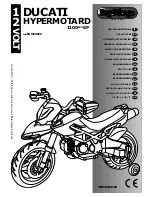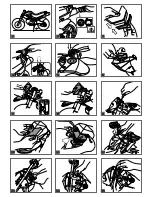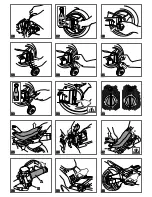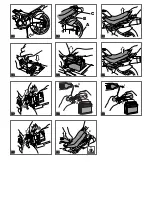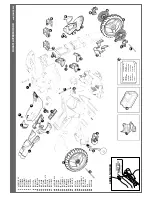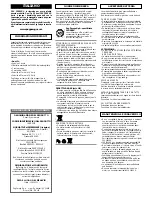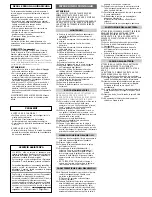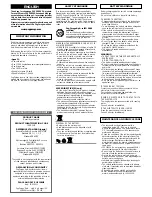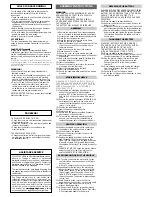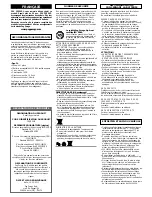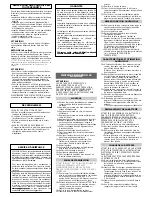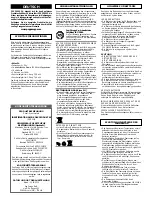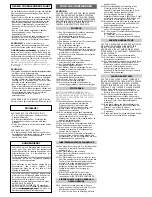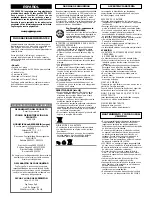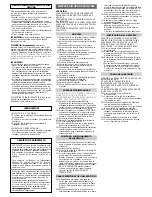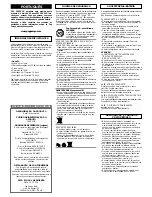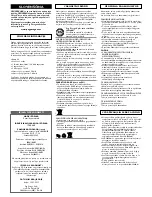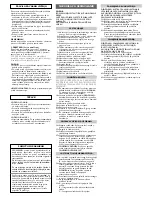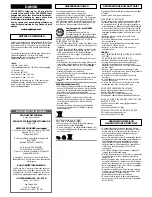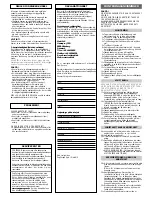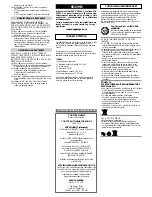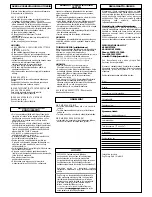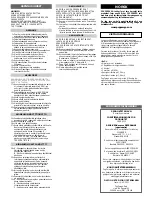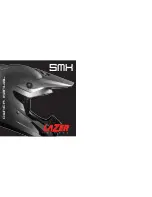
For the safety of the child, before starting up the
vehicle read and carefully follow the following
instructions.
• Teach the child how to use the vehicle properly for
safe and enjoyable driving.
• The toy must be used with caution, as it requires
substantial dexterity in order to avoid falls or
collisions which could cause injuries to the user or
third parties.
• Before starting, check that there are no people or
objects obstructing the vehicle’s path.
• Drive with hands on the handlebars/steering wheel
and always watch the road ahead.
• Brake in good time to avoid collisions.
ATTENTION!
The item is equipped with a brake system which
needs to be appropriately illustrated to the child by
an adult.
2nd GEAR (if present)
Initially, use in 1st gear is recommended. Before
enabling 2nd gear, check that the child has learned to
use the handlebars/steering wheel, 1st gear and the
brake correctly, and has become familiar with the
vehicle.
WARNING: In order to avoid the risk of the vehicle
overturning on bends, it is recommended that you do
not use high speeds (2nd gear) when the stabilising
wheels are fitted.
WARNING!
• Check that all the wheel fixing studs/nuts are
fastened properly.
• If the vehicle is overloaded, as can happen on soft
sand, mud, or very uneven ground, the overload
switch will immediately disconnect the power. The
power supply will be restored after a few seconds.
• Only for 12 and 24 Volt vehicles: in first gear the
vehicle has a differential effect like a real motor
vehicle; on smooth terrain and with just one child
on board, the two wheels can turn at different
speeds and they can slip and slow down.
UNINTERRUPTED FUN: Keep a spare set of charged
batteries ready for use.
THE VEHICLE DOES NOT WORK?
• Check that there are no disconnected cables under
the accelerator plate.
• Check the operation of the accelerator button and
replace it if necessary.
• Check that the battery is connected to the
electrical system.
THE VEHICLE LACKS POWER?
• Charge the batteries. If after charging the problem
persists, have the battery and charger checked by
an assistance centre.
PROBLEMS?
RULES FOR SAFE DRIVING
PEG PEREGO
offers an after-sales assistance service,
directly or through a network of authorized
assistance centres, for any repairs or replacements
and the sale of original spare parts. To contact the
assistance centres refer to the “Assistance Centres”
booklet included in the packaging.
The item’s serial number must always be quoted. See
the page on spare parts to find out how to identify the
serial number.
Peg Perego always strive to best satisfy their
customers' needs. Knowing the opinions of our
customers is therefore very important and valuable
to us. We would be very grateful if, once you have
used the product, you would fill out the
CONSUMER
SATISFACTION QUESTIONNAIRE
which you can find on
the internet at: www.pegperego.com, making
any observations or suggestions you might have.
ASSISTANCE SERVICE
WARNING
THE VEHICLE MUST BE ASSEMBLED BY ADULTS.
BEWARE WHEN EXTRACTING THE VEHICLE
FROM THE PACKAGING.
ALL THE NECESSARY SCREWS AND SMALL
COMPONENTS ARE STORED IN A BAG INSIDE
THE PACKAGING.
THE BATTERY MAY ALREADY BE INSTALLED.
ASSEMBLY
1 • Remove the motorcycle from its packaging and
lower the stand to facilitate assembly operations.
2 • Press the two ends of the exhaust pipes into place.
3 • Press the rear tail glass into place.
4 • Press the rear tail to the motorcycle frame.
5 • Press the fuel cap into place.
6 • Insert the dashboard tab in the upper part of the
top of the cover and then turn and press to
complete insertion.
7 • Insert the cover in the front fork sockets.
8 • Press down until it clicks.
9 • Secure the cover using the screws provided.
10 • Apply the silver adhesive contained in the packet
of adhesives.
11 • Apply the front headlight glass. To facilitate this
operation, attach the lower part first.
12 • Insert the handlebar.
13 • Connect the throttle terminal to the terminal
protruding from the fuel tank.
14 • Insert the terminals in the fuel tank.
15 • Apply the handlebar plate.
16 • Secure the handlebar plate using the two screws
provided.
STABILISING WHEELS
WARNING: IN ORDER TO AVOID THE RISK OF
THE VEHICLE OVERTURNING ON BENDS, IT IS
RECOMMENDED THAT YOU DO NOT USE HIGH
SPEEDS (2nd gear)WHEN THE STABILISING
WHEELS ARE FITTED.
17 • To assemble the stabilising wheels unscrew the
bolts of the rear wheel with the spanner
provided. NOTE: If the bolt does not unscrew,
hold the bolt on the other side with a pair of
pliers.
18 • Remove the washer and spacer (WARNING: do
not dispose of the spacer; when you wish to
remove the stabilising wheels you will need to
return it to its place).
19 • Position the stabilising wheel.
20 • Insert the washer removed earlier.
21 • Replace the bolt.
22 • Secure with the spanner provided. Repeat the
above steps on the other side.
23 • To remove the stabilising wheels repeat the
above in the reverse order, remembering to
replace the spacer before the washer and bolt.
VEHICLE OPERATION
24 • Release the saddle by turning the red latch on
the saddle to the position shown in panel A.
25 • Lift and remove the saddle.
26 • Connect the battery terminal to that of the
electrical system.
27 • Replace the saddle by sliding it under the fuel
tank. If needed, lift the tank as shown in the
figure. Turn the red latch on the saddle as shown
in panel B of figure 24. Warning: Always secure
the saddle with the latch. The vehicle is ready for
use.
• IMPORTANT NOTE: Charge the battery before
using the vehicle for the first time (see the
section IMPORTANT INFORMATION).
FEATURES AND USE OF THE VEHICLE
28 • A-Throttle: to operate the motorcycle, rotate
the throttle downwards as shown in the figure
by the arrow.
B-Horn: To operate the horn press the button.
29 • Speed Selector Button: when the motorcycle
leaves the factory it is set to travel at the first
speed (lower speed). To use the second speed
(higher speed), press the button shown in the
figure. NOTE: to access the button open and
remove the saddle. The button is situated below
the fuel tank.
30 • Brake Pedal: to brake, rotate the throttle
upwards and press your foot on the brake pedal.
31 • Stand: to be used when the motorcycle is
without stabilising wheels.
32 • A-Rubber tread for better grip and quietness.
B-Photoengraved details with carbon fibre effect.
C-Photoengraved saddle for better grip
ASSEMBLY INSTRUCTIONS
REPLACING THE BATTERY
PLEASE NOTE: THE PICTURES OF THE BATTERIES
ARE FOR ILLUSTRATIVE PURPOSES ONLY. YOUR
BATTERY MAY BE DIFFERENT FROM THE MODEL
SHOWN. THIS DOES NOT AFFECT THE
REPLACEMENT AND CHARGING PROCEDURES
DESCRIBED.
33 • Open the saddle, as described above.
34 • Unscrew the battery holder screws. Remove the
battery holder.
35 • Disconnect the battery terminal from that of the
electrical system, pushing the terminals sideways.
• Remove and replace the battery. Reposition the
battery holder and tighten the screws. Reconnect
the terminals. Reposition the saddle and lock it
back in place.
CHARGING THE BATTERY
WARNING: BATTERY CHARGING AND ANY
OTHER WORK ON THE ELECTRICAL SYSTEM
MUST BE CARRIED OUT BY ADULTS.
THE BATTERY CAN ALSO BE CHARGED
WITHOUT REMOVING IT FROM THE TOY.
36 • Open the saddle, as described above.
37 • Disconnect the battery terminal (B) from that of
the electrical system (A) by pushing sideways.
38 • Plug the battery charger terminal into a wall
socket following the instructions enclosed.
Connect terminal B to the battery charger
terminal C.
39 • Once charging is complete, unplug the charger
from the wall socket, then unplug terminal C
from terminal B.
40 • Push plug B, until it clicks, into plug A.
41 • At the end of this operation remember to close
and latch the saddle.
Содержание DUCATI HYPERMOTARD 1100 EVO SP
Страница 2: ...1 2 3 4 5 6 7 8 9 12 11 10 15 14 13 ...
Страница 3: ...1 2 A B A B 16 17 18 19 21 20 22 23 24 27 26 25 30 29 28 ...
Страница 4: ...1 2 B C 1 2 B C 1 2 31 32 33 34 35 36 37 38 39 41 40 B C A A A B B ...
Страница 38: ......
Страница 39: ......

